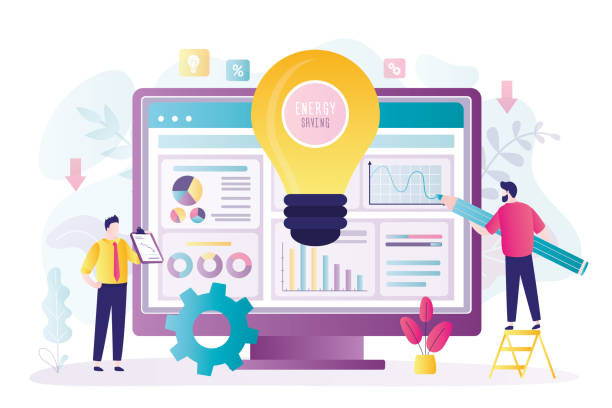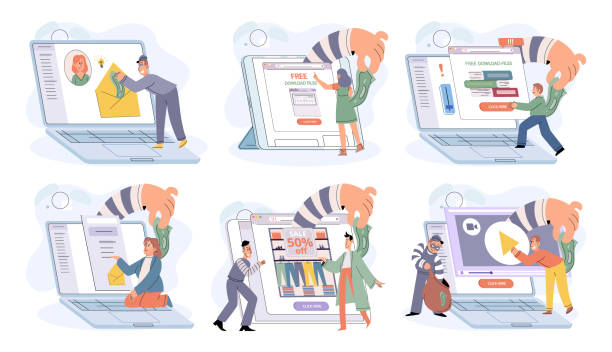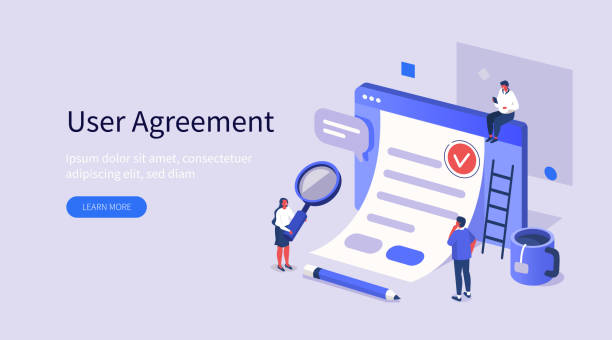The Importance of Professional Website Design in Today’s World

In the current digital age, an online presence is essential for any business or individual seeking visibility and connection with their audience.
A website is your digital storefront and will be the first point of contact for many potential customers with your brand.
Therefore, the #importance of professional website design is not merely about having a beautiful appearance; rather, it extends to creating a flawless user experience, providing #valuable content, and ensuring the website’s correct and fast #performance.
This educational and explanatory section will help you gain a better understanding of how a professionally designed website can impact your business’s success.
A well-designed website not only builds #customer_trust but also increases conversion rates and ultimately leads to your business growth.
Imagine a customer entering a store with poor layout, a messy appearance, and confusing information; they will quickly leave.
Your website is no different.
A poorly designed website can quickly drive visitors away and direct them towards your competitors.
In contrast, a professional website design can showcase your brand in the best possible way, allowing you to stand out in the competitive online space and convey your message correctly to the audience.
Furthermore, #search_engine_optimization from the very beginning of the design process plays a key role in your website’s visibility.
This approach ensures that your site is not only visually appealing but also technically ready to achieve high rankings in search results.
In summary, investing in a meticulously and expertly designed website is an investment in the future of your business.
This helps you to be well #positioned in online markets and experience sustainable growth.
The more appealing, user-friendly, and efficient your site is, the greater your chances of success in attracting and retaining customers will be.
Are you tired of your company’s website not meeting your expectations? With RasaWeb, design a professional website that truly represents your business.
✅ Increase new customer acquisition and sales leads
✅ Boost your brand’s credibility and trustworthiness among the audience
⚡ Get a free website design consultation!
Key Pillars of a Successful and Specialized Website Design

To achieve a truly successful and professional website design, special attention must be paid to a set of core pillars that go beyond mere visual aesthetics.
These pillars include an attractive and user-friendly #User_Interface (UI), a smooth and logical #User_Experience (UX), #quality and relevant content, high #loading_speed, strong #security, and #compatibility with various devices (responsive).
A successful website should guide the visitor at every stage of interaction with the site and create a positive experience for them.
From a technical perspective, this means adhering to coding standards, using up-to-date technologies, and ensuring accessibility for all users.
The site’s content should not only be informative and engaging but also structured in a way that is easy to navigate and understand.
This guidance will help you build a website that is not only aesthetically pleasing but also functionally flawless.
For instance, a strong User Interface should have clear and easy navigation (menu) so that users can easily find the information they need.
Website loading speed is also a crucial factor; studies have shown that users expect a website to load in less than three seconds, otherwise, the likelihood of them leaving the site increases.
Furthermore, given the increasing use of mobile devices for internet access, responsive design is no longer a mere advantage but a necessity.
This means your website must display well and maintain its functionality on any screen size, from desktops to tablets and mobile phones.
Site security must also be a priority to protect user information and sensitive website data from cyberattacks.
Professional website design must consider all these aspects to create a powerful and lasting online platform that not only meets your business needs but also provides an excellent user experience for visitors.
This comprehensive approach guarantees your website’s long-term success in the online space.
User Experience (UX) and User Interface (UI) in Web Design

At the heart of a professional website design lie the concepts of #User_Experience (UX) and #User_Interface (UI), which, although related, have key differences.
UI refers to the visual look and feel of your website; it includes colors, fonts, buttons, images, and overall layout.
This is the part with which the user has #visual_interaction.
On the other hand, UX deals with the user’s overall experience when using your website; Is the site easy to #navigate? Is information easily accessible? Is the purchasing or registration process smooth and frictionless? This analytical section examines these two vital concepts and explains their importance in building a successful website.
An attractive UI without strong UX is like a luxurious car that is difficult to drive.
Users might initially be drawn to the site’s appearance, but if they cannot easily achieve their goal, they will quickly leave.
Therefore, to achieve professional website design, both aspects must be designed harmoniously and meticulously.
Focusing on UX means understanding user needs and behaviors to provide logical paths for them to achieve their goals on the site.
This includes research processes, user testing, and continuous optimization.
For example, ensuring that Call-to-Action buttons are clear and visible, or that input forms are designed to be short and simple, are all part of UX improvement.
The combination of a beautiful UI and an efficient UX makes users enjoy interacting with your website, increasing the likelihood of their return and conversion.
Below, a comparative table is presented for a better understanding of these two concepts:
| Feature | User Experience (UX) | User Interface (UI) |
|---|---|---|
| Main Focus | User’s feelings, efficiency, and overall satisfaction | Visual appearance and feel, graphic elements |
| Goal | Making product use easy and enjoyable | Providing an attractive and understandable appearance for the product |
| Tools | Personas, user journey maps, user testing, wireframes | Photoshop, Sketch, Figma, color and font selection |
| Key Questions | Can the user achieve their goal? Is the process smooth? | Is the appearance attractive? Are the elements arranged correctly? |
| Sample Activities | User research, information architecture, usability testing | Logo design, color palette selection, icon design |
It is this synergy between UI and UX that will guarantee your website’s success in attracting and retaining users, turning it into a true example of professional website design.
Responsive Design and Mobile-First Approach in Modern Websites

In today’s world, where a significant portion of internet traffic occurs via mobile devices, #Responsive_Design is no longer an option but a necessity for any professional website design.
The #Mobile-First approach also means that the website design and development process begins with smaller screens (like mobile) and then gradually adapts to larger screens.
This specialized guidance will help you understand why these approaches are crucial for your website’s success.
Websites not designed responsively do not display correctly on mobile devices; texts become too small, images go out of frame, and buttons become unclickable.
This severely harms the user experience and causes users to quickly leave the site.
On the other hand, search engines like Google give higher priority to websites optimized for mobile, which directly impacts your site’s #ranking in search results.
Implementing responsive design means that your website automatically adjusts its size and layout using flexible grids, adaptable images, and media queries according to the user’s device #display_size.
This ensures that no matter what device (mobile, tablet, laptop, or desktop) the user employs to visit your site, they will always have a consistent and optimized user experience.
The mobile-first approach compels developers to address the core content and functionalities of the website first, getting rid of any complexities or unnecessary content that might disrupt the mobile experience.
This, in turn, leads to the creation of lighter, faster, and more user-friendly websites.
A modern professional website design, without considering these principles, is doomed to fail in today’s competitive environment.
Therefore, when planning to design or redesign your website, be sure to ask your developers to prioritize these principles to ensure that your website remains relevant and efficient in the future.
Is your current e-commerce website design causing you to lose customers and sales?
RasaWeb is your solution, with modern and user-friendly e-commerce website designs!
✅ Significant increase in conversion rates and sales
✅ Building strong branding and gaining customer trust
⚡ Get a free e-commerce website design consultation from RasaWeb!
Search Engine Optimization (SEO) in Website Design

Search Engine Optimization, or #SEO, is an integral part of any modern professional website design.
Regardless of how beautiful or user-friendly your website is, if it cannot be found by search engines like Google, it cannot achieve its goals.
This educational and specialized section addresses the importance of integrating SEO principles from the very early stages of website design.
SEO is not only about selecting appropriate #keywords and producing quality content, but it also includes technical aspects of the website such as URL structure, page loading speed, crawlability by search engine robots, and #indexability.
#Professional_website_design must embed these principles at its core so that your website is ready from the outset to achieve high #rankings in search results.
For example, using unique and relevant Title Tags and Meta Descriptions for each page helps search engines better understand the page content.
Logical and short URL structures are not only beneficial for SEO but also help users better understand the page’s content.
Page loading speed, as mentioned earlier, is one of Google’s important ranking factors; slow websites achieve lower rankings and provide a poorer user experience.
Additionally, using XML Sitemaps and robots.txt files helps search engines discover and index your website’s pages more effectively.
Images on the website must also be optimized; using appropriate Alt tags for images not only helps SEO but also improves site accessibility for visually impaired individuals.
The ultimate goal of SEO is to attract #organic and targeted traffic to your website.
This type of traffic consists of users who are looking for specific products or services that your website offers, and consequently, their likelihood of conversion into customers is higher.
The precise integration of SEO principles into the professional website design process is a long-term investment that significantly contributes to your visibility and success in the online space.
Neglecting SEO in the early design stages can lead to costly future changes and missed opportunities for customer acquisition.
Content Strategy for a Professional and Effective Website

Content is king; this statement never loses its validity in the world of #professional_website_design and digital marketing.
A #specialized_website_design without a strong content strategy is like a luxury car without fuel.
Your content should not only be informative and engaging but also answer your audience’s questions and #create_value.
This explanatory and guidance section addresses the importance of developing a comprehensive content strategy that aligns with your overall business objectives.
Content strategy involves planning, creating, publishing, and managing your website’s content.
This process begins with a deep understanding of your #target_audience; what are their needs, problems, and questions? By answering these questions, you can produce content that is truly useful to them.
Content types can include blog articles, service pages, product descriptions, videos, infographics, and case studies.
The main goal is to attract, engage, and convert visitors into loyal customers.
For example, if you have an e-commerce website, detailed and appealing product descriptions, high-quality photos, and customer reviews are all part of your content strategy.
For service-based websites, specialized blog articles that address common customer issues can establish you as an authoritative source in your field.
Using relevant #keywords in your content is also crucial for SEO and helps search engines introduce your website to the right audience.
Furthermore, regularly updating content and publishing new content not only encourages users to return but also sends positive signals to search engines, indicating your website’s activity and freshness.
This can help improve your ranking.
The content strategy should also include a plan for content distribution across various channels like social media and email marketing to ensure maximum visibility for your content.
Ultimately, a successful content strategy is a vital component of professional website design that helps you not only attract traffic but also convert that traffic into loyal customers.
New Tools and Technologies in Professional Website Design

The world of #professional_website_design is constantly evolving, with new tools and technologies introduced daily to make the process simpler and more efficient.
Understanding and utilizing these tools is essential for any web designer and business looking for #professional_website_development.
This specialized and news section introduces some of the most important tools and platforms used in modern web design.
From Content Management Systems (CMS) like #WordPress and Joomla, which allow for website creation and management without extensive #coding, to advanced frameworks like React, Angular, and Vue.js, which enable developers to build interactive and complex web applications.
For User Interface (UI) and User Experience (UX) design, tools like Figma, Adobe XD, and Sketch help designers create visual designs and interactive prototypes.
Image optimization tools, code compression, and website speed testing are also of high importance to ensure the website loads quickly and performs optimally.
Furthermore, with the advent of #Artificial_Intelligence and machine learning, tools are emerging that can automate the design process or offer suggestions for improving website performance.
Choosing the right tool depends on your project’s needs and goals.
For small and medium-sized websites, a CMS like WordPress, which has thousands of plugins and themes, can be a very suitable option.
For larger projects and complex web applications, JavaScript frameworks can provide more power and flexibility.
The use of version control tools like Git is also essential for development teams to manage code changes in an organized manner.
A professional website design always utilizes the latest and most efficient tools to ensure quality and optimal performance.
Below is a table of popular tools:
| Category | Tool | Main Use |
|---|---|---|
| Content Management System (CMS) | WordPress | Building various types of websites, blogs, online stores without coding |
| UI/UX Design | Figma | User interface design, prototyping, team collaboration |
| Frontend Framework | React | Developing dynamic and single-page user interfaces |
| Code Editor | Visual Studio Code (VS Code) | Integrated development environment for various programming languages |
| Version Control | Git | Managing and tracking changes in project code |
| Web Hosting | Cloud Hosting | Storage and processing space for websites |
| Web Analytics | Google Analytics | Analyzing website traffic and user behavior |
By being aware of these tools, you can make more informed decisions for your website project and ensure you are using the best available technologies to achieve your goals.
Website Security and Maintenance for Professional Website Design

One of the often-overlooked aspects of professional website design is the discussion of #security and regular #maintenance.
A secure and up-to-date website not only protects your and your users’ information but also helps maintain your brand’s #credibility.
This guidance and analytical section addresses the importance of this topic and provides tips for maintaining your website’s security and efficiency.
Cyber threats are increasing, and websites are attractive targets for hackers.
Attacks can include malicious code injection, database breaches, DDoS attacks, and information theft.
A hacked website can harm your business’s reputation, compromise sensitive information, and lead to customer loss.
Therefore, security measures must be considered from the very website design stage.
Using an SSL certificate (HTTPS) for encrypting communications is essential.
Additionally, #updates of the Content Management System (CMS), plugins, and themes are one of the simplest and most effective ways to prevent vulnerabilities.
Developers should always follow secure coding practices and properly validate user inputs to prevent SQL injection and XSS attacks.
Implementing a Web Application Firewall (WAF) and using strong passwords and two-factor authentication for the admin panel are also vital measures.
Besides security, regular website #maintenance is also essential for its optimal performance.
This includes regular #data_backups, checking for broken links, database optimization, and monitoring website performance.
A poorly maintained website may slow down, have unexpected errors, or even completely cease to function.
These issues not only disrupt the user experience but can also negatively affect your SEO and search engine rankings.
Investing in security and maintenance is an inseparable part of the professional website design strategy that protects your business from risks and ensures its smooth and reliable operation in the long term.
Ignoring these aspects can have irreparable consequences for your online presence.
Are you tired of losing business opportunities due to not having a professional corporate website?
RasaWeb helps you with professional corporate website design:
✅ Build a powerful and reliable image for your brand
✅ Convert website visitors into loyal customers
⚡ Get a free consultation now!
Future Trends in Professional Website Design

The world of #professional_website_design is never static and is constantly evolving.
Familiarity with #future_trends is crucial for any business and individual looking to maintain #competitiveness in the online space.
This news and entertaining section discusses some of the most important trends expected to shape the web design industry in the coming years.
One of the most prominent trends is #Artificial_Intelligence (AI) and Machine Learning (ML), which are increasingly being integrated into web design processes.
From automated design tools that operate based on user data to smart chatbots and voice assistants that personalize the user experience, AI has immense potential to revolutionize the web.
#Voice_search is also increasing due to the popularity of voice assistants like Siri and Alexa, and optimizing websites for Voice SEO will become an important skill.
#Virtual_Reality (VR) and #Augmented_Reality (AR) are also finding their place on the web.
Immersive experiences such as virtual tours, product previews in real space via AR, and web-based games all indicate a more interactive future for the web.
Web developers must be ready to work with these technologies and create innovative user experiences.
Sustainability and green design are also becoming important topics.
With increasing public awareness of climate change, websites are moving towards less energy consumption and resource optimization to reduce their carbon footprint.
This includes code optimization, using smaller image sizes, and choosing green hosting providers.
#Micro-animations and interactive movements will also continue to be popular for enhancing user experience and adding visual appeal to websites.
Cybersecurity will also be more important than ever due to the increasing complexity of attacks, and the use of more advanced security protocols and #blockchain_technology will increase for greater transparency and data security.
Overall, the future of professional website design is moving towards more personalization, higher interaction, greater speed, and environmental sustainability.
Preparedness for these trends is key to success in the dynamic digital world.
Conclusion and Why You Should Invest in Professional Website Design

In conclusion, all discussions presented in this #explanatory article emphasize a central point: investing in a professional website design is not an expense, but a #strategic_investment for the long-term #success of any business or online project.
A website designed with precision, expertise, and a comprehensive approach will be your main gateway to the digital world, and the first impression many audiences will have of your brand.
This investment is vital for several key reasons: First, increased #credibility and #trust.
A professional website conveys your seriousness, quality, and expertise.
Customers tend to trust businesses with a strong and tidy online presence more.
Second, improved user experience and conversion rates.
As discussed earlier, a website with strong UX/UI simplifies and enhances the user interaction process, which directly leads to an increase in conversion rates (whether sales, sign-ups, or any other goal).
Third, achieving higher #rankings in search engines.
By correctly integrating SEO into the design process, your website will have a greater chance of being seen by its target audience, which means more organic traffic and ultimately, more customers.
Fourth, future compatibility.
With approaches like responsive design and considering future trends, your website will be more resilient to technological changes and reduce the need for costly redesigns in short intervals.
And fifth, standing out in the #competitive_market.
In a world where online competition is intense, a website with professional website design can differentiate you from competitors and create a sustainable competitive advantage for you.
From an entertaining perspective, view your website as a work of art that is both beautiful and functional.
Just as an artist pays attention to detail, every pixel and every line of code matters in website design.
It is this collaborative effort between the designer, developer, and business owner that transforms a simple page into a powerful tool.
Therefore, choosing an expert team for your professional website design is one of the best decisions you can make for your business.
Frequently Asked Questions
| Question | Answer |
|---|---|
| What does professional website design mean? | Professional website design refers to creating a user-friendly, visually appealing, fast, secure, and search engine optimized website that fulfills business objectives. |
| What are the most important features of a professional website? | Responsiveness, high speed, security, SEO-friendliness, excellent User Experience (UX) and User Interface (UI), quality content, and strong branding. |
| Why is responsive design crucial for a professional website? | Responsive design ensures your website displays correctly on any device (computer, tablet, mobile), which is very important for user experience and Google ranking. |
| What is the role of UI and UX in professional website design? | UX (User Experience) focuses on ease of use and user satisfaction, while UI (User Interface) addresses the visual appearance and user interaction with the website. Both are essential for attracting and retaining the audience. |
| What is the place of SEO in professional website design? | SEO is one of the core pillars. A professional website must have a strong technical structure, optimized content, and high speed to achieve a good ranking in search engine results and be visible. |
| What tools or platforms can be used for professional website design? | Content management platforms like WordPress, Joomla, or Drupal; web development frameworks like React, Angular, or Vue.js; and graphic design tools like Figma or Adobe XD. |
| What are the main steps in designing a professional website? | Planning and research, wireframe and mockup design, development and coding, content entry, testing and review, and finally launch and maintenance. |
| What is the importance of security in a professional website? | Website security is crucial for protecting user information and business credibility. Using SSL/TLS, firewalls, regular backups, and updates are vital measures. |
| Does a professional website require maintenance after launch? | Yes, regular maintenance, including software updates, checking for broken links, performance monitoring, backups, and adding fresh content, is essential to maintain the website’s efficiency and ranking. |
| What distinguishes a professional website from an amateur one? | A professional website focuses on business goals, offers an exceptional user experience, adheres to high technical standards, and is continuously optimized for improvement, whereas an amateur website typically lacks these features. |
And other services from RasaWeb Advertising Agency in the field of advertising
Selecting suitable colors for medical product advertisements
How to leverage storytelling in medical product advertisements?
Increasing audience engagement with medical product advertisements
Using video to introduce medical products on industrial websites
How to optimize advertisements for social media related to industrial websites?
And over a hundred other services in the field of online advertising, advertising consultation, and organizational solutions
Online Advertising | Advertising Strategy | Advertorial
🚀 Are you ready for your business to grow and shine in the digital world? RasaWeb Afarin Digital Marketing Agency paves your path to success by offering comprehensive and professional services, including custom website design, Search Engine Optimization (SEO), and content marketing strategies. Build a brilliant future for your brand with us and take a big step towards progress.
📍 Tehran, Mirdamad Street, Next to Central Bank, Southern Kazeroun Alley, Ramin Alley, No. 6



